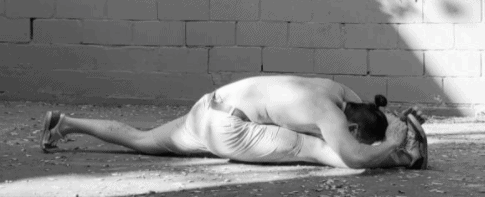I was trained, like most people, not to stretch before any workouts. As an Olympic lifter, I was told that it would sap my power if I stretched before strength training. Other fitness programs may have taught you that you can injure yourself if you stretch before warming up or exerting.
Turns out the opposite is what’s true.
From both my experience and from deep research over the last several years, I’ve learned that our bodies’ natural progression is to want to open up first, then take on getting stronger. And I learned it by experimenting on myself, having never done the splits or back bridge as an adult.
I saw a change immediately in my own workouts. When I applied the right SEQUENCE of events, I am not going to lie. I could start doing things COLD. Absolutely no warm-up and it shocked me. So I took it further and pushed the envelope to see if it worked and it did.
Then I taught the basic idea to my clients and now I want to share with you.
Free up your range of motion FIRST, THEN do a little weight training.
You can see a quick change and the results will actually last.
Stretching isn’t just about avoiding cramps or to make your body obey whatever you want it to do. Stretching at the right time is a critical part of the recipe for making your body stronger.
It’s like being a good baker. You don’t just focus on one part of a dish. Things need to be added together in the right timing to create the delicious result.
Common “Wisdom” & Stretching “Farther”
The problem with group fitness is that vigorous classes will end with stretching…when you’re tired. If your inner protection reflex (called the myotatic reflex) is weak, it cannot do its job to prevent you from overstretching and injuring yourself.
We have been taught that if we keep leaning into a stretch, eventually we can go farther. But the problem with this logic is that we are more likely to exhaust the inner protection feeling, and go into an unsafe range of motion. Your body is telling you with that feeling that you needed to be careful, and if we tire the reflex out to it doesn’t give us the alarm, we can’t know to stop pushing.
Here’s your rule of thumb: Don’t push your stretches when you’re already tired.
Stretching after workouts is good ONLY when you’re helping your nervous system calm down. It’s not effective in increasing your flexibility and is more likely to injure you.
“So how should I fit my stretching in, Brandon? Can you give me a better program?”
Your training doesn’t have to be nice and neat and structured. You identify the muscle and stretch it and then you strengthen it within the next few minutes. If you do that enough over the course of a few workouts, you will see lasting results.
It doesn’t have to be so formal. You don’t have to put on your Lululemon’s on and set up the gym and do all the blah blah. Just while brushing your teeth, or eating your Chipotle burrito on the couch, you can take a couple minutes to stretch a limb, and then follow up with strengthening it. Just do this when you’re fresh, not tired from a workout.
When you stretch first and move into a new range for your body, it’s a little confused at first. It’s like “huh, I haven’t been here before. Is this good or bad?”
And then you want to answer that question to tell your body it’s good by activating your muscles while it’s in that range.
Your body needs to go through the new movement range while being both relaxed AND having protective tension (like how it feels when you flex your bicep).
A good rule of thumb is stretching for 60-90 seconds, then doing 60-90 seconds of tensioned movement (like adding a weight or resistance band or flexing/squeezing the muscles around the area while moving).
So when you try this, you will see a change within the workout itself. It’s a sign you have done something IN AGREEMENT with your body. The longer you do this, the more you’ll see lasting results.
Loosens hamstrings and back.
Opens the ankles, knees, and hips up while preparing you for anything involving walking/running.
Opens up the chest, front abs, and helps you squeeze those underused upper back/neck muscles.

